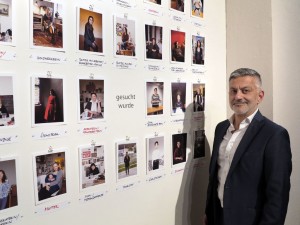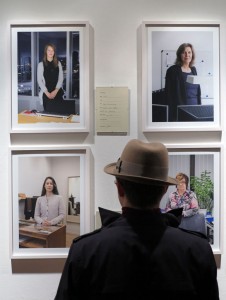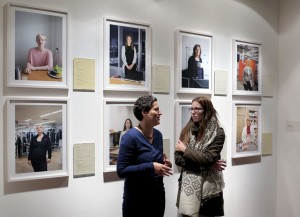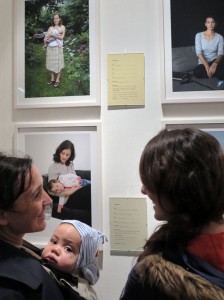Ashkan Sahihi’s most recent body of work is a portrait of a rapidly changing Berlin comprising 375 photographs of women living in Berlin gathered by thirty-five search terms such as professions, age brackets, lifestyles, social strata. All of the images embody in an individual way the dynamics of today’s Berlin. Taken together, the portraits represent a cautious exploration of the vibrant city of Berlin, an attempt to capture a moment in the city. “The woman of Berlin“ is on the wall in two galleries in Berlin. Hurry up to admire the body of work until January 10th, 2016 at Galerie im Körnerpark and through February, 6 2016 at Galerie Springer. All 375 prints are done on Hahnemühle PhotoRag® Ultra Smooth by print studio d‘mage light Berlin – a Certified Studio supported by Hahnemühle. We are proud to feature an interview with Iranian born photographer Ashkan Sahi – currently living in Berlin. Enjoy reading!
 When did you discover your passion for photography?
When did you discover your passion for photography?
When I realized how much feeling, information, passion and story could beconveyed in a single image and a split second of viewing a picture. When I realized that pop culture was increasingly moving away from written and spoken language to the visual. I was very drawn to the arts from very young age and could observe how people (including myself) still yearned for stories and narratives, but were getting increasingly used to faster methods of intake (magazines instead of books, TV and movies instead of theater and ballet).
I am not suggesting that this is always a good thing, but it is how I got very passionate about telling stories independent of language and with photographs.
How did you come to the world of portrait photography?
I was born in Tehran, went to school in Germany, moved to New York as a very young man and ended up traveling a great deal throughout my life. I have been an outsider, guest or the new arrival in town my entire life and have always wanted to understand what it is that moves my fellow man. I always assumed that the story of their lives was in their faces. If there is any sort of manifest outward essence of the human experience it  is probably our face.
is probably our face.
Which of your projects/motifs opened the door to the art market/professional market?
The Drug Series in the year 2000. I asked 11 complete non-users to ingest an illegal drug each (LSD, cocaine, heroin, etc) and I photographed their portraits during the intoxication, the ‘high’. This series of 11 large format portraits led to my first solo show at P.S.1/MoMA curated by Klaus Biesenbach and the collaborations with curators and museums internationally.
Any artist in any field who embraces and implements the constant need to re-invent yourself not only as method of economic success but also, if not more-so, for your own creative fulfillment and personal growth.
How would you describe your personal photographic style?
I believe one can use different styles (and techniques) depending on what ‘feel’ you want to create for the story you are looking to tell. I used very different styles for the different conceptual series I shot and exhibited over the years. The ‘Drug Series’ looks and feels almost medical, the ‘Kiss Series’ is very glossy and ‘Guantanamo Bay’ is a calm b/w study. Since the question ask for my personal style I would say narrative, low tech and genuinely interested in the subject of the portrait.
What is most challenging about portrait photography?
I am honestly not sure how to answer this question. Let me carefully try and say this. Like with all other artistic disciplines, there is the vast competition, the economic challenges of making a living and the task of figuring out what it is you want to say. But I also think that it is ultimately a huge, huge privilege to spend your time figuring out what you have to say and how you are going to say it.
 How important is the printed presentation of your works of art?
How important is the printed presentation of your works of art?
It is crucial. The printed presentation can make the work fly or sink the ship. It gives depth and live to the image.
Who does the prints?
My dear friends and trusted high-end print specialist Annette Berr and Ul Vohrer at d’mage in Berlin, Germany.
Which is your favorite Hahnemühle paper and why?
I love Hahnemühle Photo Rag Ultra Smooth and use it pretty much exclusively.
Do you have a dream project you would like to realize sometime?
I have a dream project AND a nightmare project I would like to realize. My dream project would be to photograph a portrait of every single head of state in the world. Queens, Kings, Lord Chancellor, Prime Minister, the whole bunch. The nightmare project I would like to realize is to travel exclusively in conflict zones (a.k.a war zones) for one full year and send one photograph a day for 365 days to a mass media outlet to be published full page as a visual diary of ‘A Year in War’.
I believe ideas loose their power and trajectory when you talk about them too much. I believe that is the case with all intensions. You better decide on something and you do it. Don’t sit around talk about it until it’s been pulverized. I have always been very discreet about projects, even when already in production and shooting. This just as any explanation and apology of sorts why I don’t want to talk about the next idea and project. The next step I am comfortable talking about is this: For the very first time I want to sit down and work through my own archives of nearly 30 years of shooting portraits and pictures internationally. The odd bit about getting older as an artist is that some of your work suddenly bares witness to human history and becomes proof of the past, without you ever having thought it could become as much. People – famous or not – die, countries big and small disappear and all other cultural signifier change (architecture, fashion, life style) and all of a sudden a single element in a shot tells us so much about who we were and might invite reflection on who we are now.
Thank you for the interview, Mr. Sahihi.
More on the photographer: https://en.wikipedia.org/wiki/Ashkan_Sahihi









